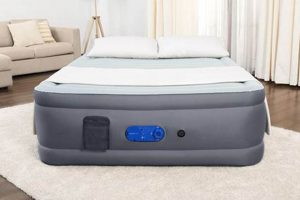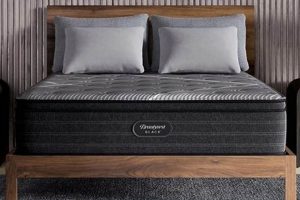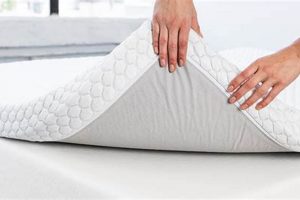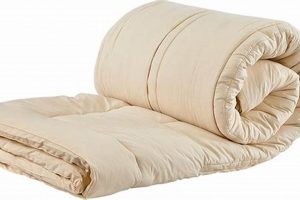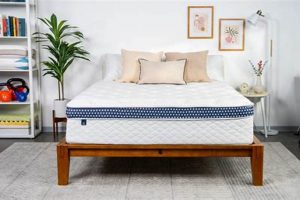A hybrid mattress designed to accommodate combination sleepers represents a bedding solution engineered to provide comfort and support across multiple sleep positions. These mattresses typically integrate elements from both innerspring and memory foam (or latex) designs, aiming to balance responsiveness, pressure relief, and spinal alignment for individuals who frequently shift positions during the night. For example, a hybrid mattress may feature a pocketed coil system for support and airflow, coupled with a top layer of memory foam for contouring and pressure reduction.
The significance of selecting a suitable mattress for combination sleepers lies in its potential to improve sleep quality and overall well-being. A well-chosen mattress can mitigate pain points, minimize sleep disruptions caused by positional changes, and promote healthy spinal alignment. Historically, sleepers had fewer options tailored to their specific needs; however, advancements in mattress technology have led to the development of sophisticated hybrid models specifically designed to cater to individuals who experience a variety of sleep positions throughout the night, thereby filling a crucial need in the market.
The remainder of this discussion will address critical factors in the selection of these mattresses, including key features to consider, different types of hybrid construction, relevant performance metrics, and guidance on choosing the ideal model based on individual needs and preferences.
Tips for Selecting a Hybrid Mattress for Combination Sleepers
The following guidelines can assist in the selection process of a hybrid mattress designed to accommodate combination sleep styles, ensuring a purchase that aligns with individual needs and preferences.
Tip 1: Consider Layer Construction: Examine the materials used in each layer of the mattress. High-density foams, pocketed coils, and breathable fabrics can contribute to enhanced comfort and support.
Tip 2: Evaluate Firmness Level: Assess personal preference for firmness. A medium-firm mattress is often suitable for combination sleepers as it provides a balance of support and pressure relief for various positions.
Tip 3: Research Motion Isolation Properties: Investigate the mattress’s ability to isolate motion. This is particularly important for individuals who share a bed, as it minimizes disturbances caused by movement during the night.
Tip 4: Check Edge Support: Determine the quality of edge support. Strong edge support allows for full use of the mattress surface and can enhance stability when sitting on the edge.
Tip 5: Analyze Temperature Regulation: Assess the mattress’s ability to regulate temperature. Breathable materials and cooling technologies can help prevent overheating during sleep.
Tip 6: Read Reviews and Ratings: Review customer feedback and independent ratings to gauge the mattress’s overall performance and durability. Prioritize reputable sources and look for trends in user experiences.
Tip 7: Check warranty and trial period: Examine warranty and trial period offered by manufacturer. Trial periods can help you try if the mattress suit your needs.
By carefully considering these factors, individuals can make a more informed decision when selecting a hybrid mattress, potentially leading to improved sleep quality and a more comfortable rest environment.
The subsequent sections will provide a more in-depth analysis of specific mattress features and performance metrics, further aiding in the identification of the ideal model.
1. Supportive Coil System
A supportive coil system serves as a foundational element in a hybrid mattress specifically designed for combination sleepers. Its role is to provide the necessary structural integrity and responsive support to accommodate the varied spinal alignment needs associated with different sleep positions. The coil system’s design directly impacts the mattress’s ability to maintain proper posture, irrespective of whether the individual is sleeping on their back, side, or stomach. For instance, a pocketed coil system, where each coil is individually wrapped, offers targeted support and minimizes motion transfer, which is crucial for combination sleepers who frequently change positions during the night.
The importance of a well-engineered coil system extends beyond simple support. It contributes significantly to the overall comfort and longevity of the mattress. A durable coil system resists sagging and maintains its shape over time, preventing the formation of pressure points that can disrupt sleep. Consider a scenario where an individual transitions from side sleeping, requiring pressure relief in the shoulders and hips, to back sleeping, necessitating firm lumbar support. A responsive coil system adapts to these changing needs, providing consistent support throughout the night. Without this adaptive capability, the mattress may fail to deliver the necessary comfort and spinal alignment for each position, potentially leading to discomfort and disrupted sleep.
In summary, the supportive coil system is not merely a component but an integral mechanism in a hybrid mattress tailored for combination sleepers. Its ability to provide consistent support, adapt to changing sleep positions, and minimize motion transfer directly contributes to improved sleep quality and overall comfort. The selection of a hybrid mattress with a robust and responsive coil system is a critical factor in addressing the unique sleep needs of individuals who frequently change positions throughout the night, and ensuring its durability and suitability.
2. Responsive Foam Layers
Responsive foam layers are a crucial element in the design of a hybrid mattress intended for combination sleepers. These layers contribute significantly to comfort, pressure relief, and adaptability as the sleeper transitions between different positions throughout the night.
- Conforming to Body Contours
Responsive foam, such as memory foam or latex, conforms to the unique contours of the body, providing customized support and pressure relief. For instance, when a combination sleeper transitions to a side-sleeping position, the foam compresses to accommodate the shoulders and hips, reducing pressure buildup in these areas. This adaptability is essential for maintaining comfort and minimizing discomfort during sleep.
- Enabling Ease of Movement
Unlike some traditional foam materials, responsive foam quickly returns to its original shape when pressure is removed. This characteristic is vital for combination sleepers who frequently change positions. The responsiveness of the foam allows for ease of movement and prevents the feeling of being “stuck” in the mattress, facilitating
smooth transitions between different sleeping positions. - Enhancing Motion Isolation
Responsive foam can effectively absorb and isolate motion, minimizing disturbances for co-sleepers. When one partner shifts positions during the night, the responsive foam layers dampen the movement, preventing it from transferring across the mattress. This feature is particularly beneficial for couples where one or both partners are combination sleepers.
- Promoting Airflow and Temperature Regulation
Some responsive foams are designed with open-cell structures or infused with cooling gels to enhance airflow and regulate temperature. This is significant for combination sleepers who may experience varying levels of body heat throughout the night. Improved airflow helps dissipate heat and prevents the buildup of moisture, contributing to a more comfortable and consistent sleep environment.
In summary, responsive foam layers play a critical role in optimizing the performance of hybrid mattresses for combination sleepers. The conforming properties, ease of movement, motion isolation capabilities, and temperature regulation features contribute to a more comfortable and supportive sleep experience, ensuring that individuals can seamlessly transition between different sleeping positions without sacrificing comfort or disrupting their sleep.
3. Pressure point relief
Pressure point relief is a critical consideration when evaluating mattresses, especially for combination sleepers. Inadequate pressure relief can lead to discomfort, pain, and disrupted sleep, thereby affecting overall well-being. A mattress designed to alleviate pressure points is therefore paramount for individuals who frequently change positions throughout the night.
- Distribution of Body Weight
Pressure point relief is fundamentally linked to the distribution of body weight across the mattress surface. A mattress that effectively distributes weight minimizes concentrated pressure on specific areas such as the shoulders, hips, and knees, particularly relevant for side sleepers. A hybrid mattress achieves this through a combination of conforming foam layers and a supportive innerspring system, creating a balanced sleep surface. The innerspring provides general support, while the foam layers contour to the body, reducing localized pressure.
- Material Composition and Density
The materials used in a mattress directly impact its ability to provide pressure point relief. Memory foam and latex, commonly found in hybrid mattresses, are known for their pressure-relieving properties. The density of these materials also plays a crucial role; higher-density foams tend to offer greater support and pressure relief. A well-constructed hybrid mattress will incorporate appropriate foam densities in strategic locations to optimize pressure relief for various sleep positions.
- Conformity and Adaptability
A mattress’s ability to conform to the body’s shape is essential for effective pressure point relief. As combination sleepers transition between positions, the mattress must adapt to the changing contours of the body. Hybrid mattresses, with their combination of innerspring and foam, offer a dynamic sleep surface that conforms to the body while maintaining adequate support. This adaptability ensures that pressure is evenly distributed regardless of the sleeper’s position.
- Spinal Alignment
Pressure point relief is intrinsically linked to spinal alignment. When pressure points are relieved, the spine is more likely to maintain its natural curvature, reducing strain on the back and neck. A hybrid mattress that provides adequate pressure relief and support promotes healthy spinal alignment, contributing to a more comfortable and restorative sleep experience. This is particularly important for combination sleepers who require consistent support and pressure relief across multiple sleeping positions.
The facets discussed underscore the significance of pressure point relief in the context of selecting an optimal sleep surface. A hybrid mattress that effectively addresses these facetsweight distribution, material composition, conformity, and spinal alignmentis more likely to meet the needs of combination sleepers, resulting in improved sleep quality and overall comfort.
4. Motion Isolation Properties
Motion isolation properties are a key consideration when evaluating hybrid mattresses, especially for combination sleepers sharing a bed. The ability of a mattress to minimize the transfer of movement is critical for undisturbed sleep, as combination sleepers often change positions throughout the night, potentially disrupting a partner’s rest.
- Individual Coil Encapsulation
Hybrid mattresses with individually encased coils excel in motion isolation. Encasing each coil in fabric allows it to move independently, limiting the spread of motion across the mattress surface. For example, if one sleeper shifts position, the coils beneath that area compress or expand without significantly affecting the surrounding coils, reducing the likelihood of disturbing the other sleeper. This feature is particularly valuable for couples with different sleep schedules or varying levels of sleep sensitivity.
- Foam Layer Composition
The type and density of foam layers significantly influence motion isolation. Memory foam, known for its high density and conforming properties, absorbs motion effectively. A thicker layer of memory foam or a combination of memory foam and other specialized foams, such as latex, further enhances motion isolation. In a scenario where one sleeper is restless, the dense foam layers dampen movements, preventing them from propagating across the mattress and disrupting the other sleeper’s rest.
- Mattress Construction and Layer Arrangement
The overall construction and arrangement of layers in a hybrid mattress contribute to motion isolation. A well-designed mattress will incorporate layers that work in tandem to absorb and minimize motion transfer. For instance, a hybrid mattress might feature a base layer of supportive coils, followed by a transition layer of responsive foam, and a top layer of motion-isolating memory foam. This layered approach effectively dampens movement, ensuring that disturbances are localized and minimized.
- Edge Support Systems
While primarily designed to provide structural stability and prevent edge collapse, edge support systems can also impact motion isolation. Mattresses with reinforced edges often exhibit better motion isolation properties because the strengthened perimeter helps contain movement within the mattress. A firm edge prevents motion from easily transferring to the edges, thus reducing the likelihood of disturbing a partner who may be sleeping close to the edge of the bed.
The characteristics outlined above directly affect the suitability of a hybrid mattress for combination sleepers seeking to minimize sleep disturbances. A mattress incorporating these features is more likely to provide a restful and undisturbed sleep experience for both individuals sharing the bed. Therefore, motion isolation is a pivotal factor in determining the optimal hybrid mattress choice.
5. Edge support constr
uction
Edge support construction constitutes a significant element in determining the overall performance and suitability of a hybrid mattress, especially for combination sleepers. A robust edge support system contributes to maximizing the usable sleep surface, enhancing stability, and improving the overall lifespan of the mattress.
- Enhanced Usable Sleep Surface
Edge support prevents the perimeter of the mattress from collapsing under weight, thereby maximizing the usable sleep surface. This is particularly advantageous for combination sleepers who may move and shift positions frequently during the night, often utilizing the full width of the mattress. Without adequate edge support, the sleeper may feel as though they are rolling off the mattress, leading to discomfort and disrupted sleep. A firm edge allows sleepers to comfortably utilize the entire mattress surface, promoting a sense of security and unrestricted movement.
- Improved Stability and Support
A well-constructed edge support system enhances the overall stability and support of the mattress. It provides a consistent level of support from edge to edge, preventing sagging and ensuring proper spinal alignment regardless of sleep position. This is crucial for combination sleepers who require consistent support throughout the night as they transition between different sleeping positions. Enhanced edge support contributes to a more stable and reliable sleep surface, minimizing the risk of discomfort or pain associated with uneven support.
- Increased Mattress Longevity
Edge support construction contributes to the overall durability and longevity of the hybrid mattress. By preventing edge collapse and maintaining structural integrity, the mattress is less likely to develop sagging or indentations over time. This prolonged lifespan represents a cost-effective benefit, as the mattress retains its supportive properties for a longer period. Combination sleepers, who often exert varying degrees of pressure across the mattress surface, particularly benefit from the enhanced durability afforded by robust edge support.
- Facilitated Ease of Entry and Exit
A firm edge makes getting in and out of bed easier and more stable. This is especially important for individuals with mobility issues or those who require additional support when transitioning from a seated to a lying position. Enhanced edge support provides a stable surface for sitting on the edge of the bed, facilitating activities such as dressing and grooming. For combination sleepers, the ease of entry and exit afforded by robust edge support contributes to a more seamless and comfortable sleep experience.
In summary, edge support construction is an indispensable factor in determining the suitability of a hybrid mattress for combination sleepers. Its contribution to maximizing usable sleep surface, enhancing stability, improving mattress longevity, and facilitating ease of entry and exit collectively results in a more comfortable, supportive, and durable sleep solution that addresses the unique needs of this sleep demographic.
6. Temperature regulation features
Temperature regulation features constitute a critical attribute in evaluating a hybrid mattress designed to accommodate combination sleepers. Sleep quality is intrinsically linked to maintaining a stable core body temperature throughout the night. Combination sleepers, who frequently shift positions, often experience fluctuations in body temperature due to changes in surface contact and insulation. Inadequate temperature regulation can lead to overheating or excessive cooling, resulting in disrupted sleep cycles, restlessness, and reduced overall sleep quality. Consequently, a mattress’s capacity to effectively manage temperature is paramount for this sleep demographic.
Effective temperature regulation in hybrid mattresses is achieved through a combination of material selection and construction techniques. Breathable materials, such as open-cell foams and natural fibers like cotton or wool, promote airflow and facilitate the dissipation of heat and moisture. For instance, a hybrid mattress incorporating a layer of gel-infused memory foam, coupled with a breathable cover, can effectively draw heat away from the body, preventing overheating. Similarly, pocketed coil systems enhance airflow within the mattress core, further contributing to temperature regulation. The practical significance of these features is evident in the increased comfort and reduced sleep disturbances experienced by combination sleepers who utilize mattresses with advanced temperature regulation capabilities. Without these features, individuals may experience night sweats, discomfort, and frequent awakenings, ultimately compromising their sleep health.
In summary, temperature regulation features are not merely an ancillary benefit but a fundamental component of a well-designed hybrid mattress for combination sleepers. The ability to maintain a stable sleep environment through breathable materials, strategic construction, and advanced cooling technologies directly impacts sleep quality, reduces sleep disturbances, and enhances overall well-being. While challenges remain in optimizing temperature regulation for diverse climates and individual preferences, the integration of these features represents a significant advancement in mattress technology, specifically catering to the unique needs of combination sleepers.
Frequently Asked Questions
The subsequent section addresses frequently asked questions regarding hybrid mattresses tailored for combination sleepers, offering clarity on key considerations and dispelling common misconceptions.
Question 1: What defines a hybrid mattress and differentiates it from other mattress types?
A hybrid mattress integrates both innerspring coils and foam (memory foam or latex) layers. This construction distinguishes it from traditional innerspring mattresses, which lack substantial foam layers, and all-foam mattresses, which omit coil support systems.
Question 2: Why are hybrid mattresses often recommended for combination sleepers?
Hybrid mattresses offer a balance of support and pressure relief, accommodating multiple sleep positions. The coil system provides support for back and stomach sleeping, while the foam layers contour to the body for side sleeping comfort. This adaptability is beneficial for those who shift positions during sleep.
Question 3: How does firmness level impact the suitability of a hybrid mattress for combination sleepers?
Firmness level is a subjective preference; however, a medium-firm mattress is generally suitable for combination sleepers. This firmness level offers a balance of support and cushioning, accommodating various sleep positions without causing excessive pressure on specific areas.
Question 4: What role does motion isolation play in a hybrid mattress for co-sleepers?
Motion isolation minimizes the transfer of movement across the mattress surface. This is particularly important for couples where one or both partners are combination sleepers, as it reduces disturbances caused by shifting positions during the night. Individually encased coils and dense foam layers contribute to effective motion isolation.
Question 5: How important is edge support in a hybrid mattress for combination sleepers?
Edge support provides stability and prevents the mattress edges from collapsing under weight. This feature maximizes the usable sleep surface, which is beneficial for combination sleepers who may move close to the edges of the mattress. Strong edge support also facilitates ease of entry and exit.
Question 6: Can temperature regulation features improve the sleep experience for combination sleepers?
Temperature regulation features enhance comfort by promoting airflow and dissipating heat, preventing overheating or excessive cooling during sleep. This is particularly valuable for combination sleepers who may experience fluctuations in body temperature due to changes in position and surface contact. Breathable materials and cooling technologies contribute to effective temperature regulation.
These FAQs provide a comprehensive overview of key considerations when selecting a hybrid mattress designed for combination sleepers. Understanding these aspects can assist in making an informed decision and optimizing sleep quality.
The subsequent sections will delve into specific mattress models and brands, offering detailed comparisons and recommendations based on performance metrics and user reviews.
Concluding Remarks
The preceding discussion has explored critical aspects of selecting the best hybrid mattress for combination sleepers. Key factors examined include supportive coil systems, responsive foam layers, pressure point relief capabilities, motion isolation properties, robust edge support construction, and effective temperature regulation features. The synthesis of these elements defines the performance and suitability of a mattress for individuals who transition between various sleep positions throughout the night.
The selection of an appropriate mattress represents a significant investment in sleep quality and overall well-being. Informed decision-making, based on an understanding of individual needs and mattress characteristics, is essential for achieving optimal sleep outcomes. Continued innovation in mattress technology holds the potential to further enhance the sleep experience for combination sleepers, ensuring restorative rest and improved quality of life.



